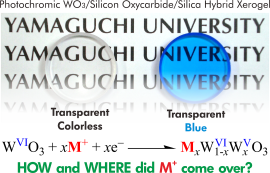論文がアクセプトされました(安達先生・山崎先生・岩楯先生 共著)
Kinetics of Coloration in Photochromic Tungsten(VI) Oxide/Silicon Oxycarbide/Silica
Hybrid Xerogel: Insight into Cation Self-diffusion Mechanisms
K. Adachi, M. Tokushige, K. Omata, S. Yamazaki, Y. Iwadate
ACS Appl. Mater. Interfaces, 2016, 8, 14019-14028.
DOI : 10.1021/acsami.6b04115
Abstract: Silicon oxycarbide/silica composites with well-dispersed tungsten(VI)
oxide (WO3) nanoparticles were obtained as transparent hybrid xerogels
via an acid-catalyzed sol–gel process (hydrolysis/condensation polymerization)
of 3-(triethoxysilyl)propyl methacrylate (TESPMA) and tetraethoxysilane
(TEOS). The self-diffusion mechanism of alkali-metal cations and the kinetics
of the photochromic coloration process in the WO3/TESPMA/TEOS hybrid xerogel
systems have been systematically investigated. Under continuous UV illumination,
a gradual color change (colorless → blue) corresponding to the reduction
of W6+ into W5+ states in WO3 nanoparticles can be confirmed from the WO3/TESPMA/TEOS
hybrid xerogels containing alkali-metal sulfates, although no coloration
of the hybrid xerogel without alkali-metal sulfate was observed. The coloration
behavior depended exclusively on a variety of alkali-metal cations present
in the hybrid xerogel system. Furthermore, a detailed analysis of the self-diffusion
mechanism confirmed that the alkali-metal cations electrostatically interact
with a layer of unreacted silanol groups on the TESPMA/TEOS matrix surface,
and subsequently pass through the interconnected pore network of the hybrid
xerogel. More interestingly, in the context of an Arrhenius analysis, we
found a good coincidence between the activation energies for alkali-metal
cation self-diffusion and UV-induced coloration in the WO3/TESPMA/TEOS
hybrid xerogel system containing the corresponding alkali-metal sulfate.
It is experimentally obvious that the photochromic properties are dominated
by the diffusion process of alkali-metal cations in the WO3/TESPMA/TEOS
hybrid xerogel system. Such hybrid materials with cation-controlled photochromic
properties will show promising prospects in applications demanding energy-efficient
"smart windows" and "smart glasses".
